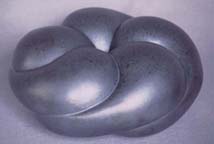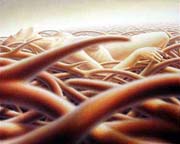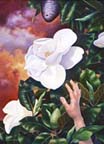Zanne Nelson’s organic ceramic forms have an unearthly feel that complement Jeff Mihalyo and Louise Britton’s playful, surrealistic paintings at Jeffrey Moose Gallery. Browsing the walls, it is at first hard to tell which of the paintings are Britton’s and which Mihalyo’s, for they have a similarity of content and style. Both paint fantastical scenes in a realistic manner with bright colors, precise rendering, and similar elements-detached, monolithic heads, tree branches, houses floating free of the earth. But where Britton’s images have sharp edges, Mihalyo’s are all soft and dreamy; while Britton juxtaposes unlike elements in a sometimes jarring way with intense, complimentary colors, Mihalyo’s invented forms are uniform in muted colors, and his images are more unified.

Mihalyo, known as the master of the O.K. Hotel mural (which mural is now, post-earthquake, sadly back in his studio), has created a unique iconography of sticks and twigs. There are other images as well -most notably a pair of twin flying barns that looks monumental and is deceptively tiny -but it is his series of paintings of limbs that stands out here. Mostly small paintings measuring 8 x 12 inches and 10 x 16 inches, these paintings are of surrealistic landscapes constructed of bunched, stacked, or interwoven twigs. Not precisely identifiable, the twigs can be seen as tree limbs or branches, or perhaps as noodles or worms, that weave in and out to form, variously, fantastical buildings or landscapes or tunnels or otherworldly monoliths. Generally oriented with sky and horizon to create a sense of place, the twigs are painted in earth tones, sometimes with reflected blues around the edges. The paintings are precisely and lovingly rendered to create the look of out-of-focus photographs with soft, halo-like edges. The unity of color and form and the reductive quality make the surrealistic imagery even more surprising, because, despite the unreal subjects, they look almost like photographs of bunches of twigs or stacks of hay in brown fields.

One of the more intriguing aspects of Mihalyo’s branch paintings is that they are small in scale but monumental in concept. They look best in groups, and one wonders if they would hold up as well as individual pieces at that scale. Are they simply studies for larger paintings? Yes, actually they are. A few larger paintings are included, and they can be viewed side by side with the “studies.” The larger paintings are more reductive and, I believe, more successful.
Thatch is one of the larger paintings. In it a briarpatch of twigs almost obliterates the form of a sleeping nude which seems to grow out of the branches. This is a powerful and beautiful painting, much stronger than the study for it. In the study Mihalyo has used blue along the edges of the limbs; in the larger version there is no color but for the soft brown of the limbs and the woman’s body.

Mihalyo’s most powerful painting in the show is a departure from the branch series. Trojans at the Harvest is a painting of the Trojan horse made of wood with a barrel body. Instead of an army marching out of the horse, there is an army of hands holding giant heads (aptly described in the press release as “Goliaths of Earth”). They are marching in military formation, and each head is asleep, cradled in the hands in the way people typically rest their heads in hand. If it is an army of destruction, it is a mindless army, comically horrible.
Britton’s paintings fall more into the surrealistic tradition of juxtaposing unlike elements, often broken into rectangular sections with each section holding an image of landscape elements or heads or flowers. Comparisons with Magritte are unavoidable. In Magnolia Burning an enormous magnolia blossom sits at the edge of foliage. A hand at the bottom of the picture reaches up as if to grasp the blossom. Clouds, smoke, and fire fill the sky, and above all hangs a hornet’s nest. There is a feeling of impending doom.

Locus of Memory is my favorite Britton painting in her exhibit. There is an indescribable strangeness to this painting -indescribable because the subject is common and the pictorial devices she uses have been used many times before, yet in this instance they work terrifically. The painting, of a small white house surrounded by large trees, is broken into two areas with contrasting color schemes. Local color is employed in the central section. The leaves of trees are painted in deep greens. The outer section is all in vibrant tones or crimson and vermilion. Although this device is common, Britton’s precise placement and vibrant color lift it above the mundane.

Both Mihalyo and Britton come out of commercial art backgrounds. Both are imaginative and technically proficient. Of the two, I think Mihalyo has taken a step or two further away from illustration. Both present images that are simultaneously comic and horrible metaphors for modern life.
Alec Clayton is a painter and writer living in Olympia, Washington. His first novel, Until the Dawn, has been released. Check it out at: http://www.xlibris.com/UntiltheDawn.html
Review Published in Art Access Magazine, May 2001